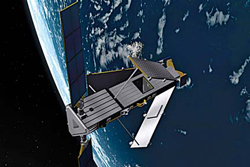
Devastating space junk collisions are becoming more and more frequent, and that’s bad news for owners of the $18 billion worth of commercial satellites, not to mention other spacecraft, currently orbiting the Earth. (Astronauts haven’t been hit by space junk, but that danger is real, too. In fact, a September 2009 spacewalk was almost scrubbed when NASA feared that orbiting rocket scrap would pass too close to the International Space Station.) At the International Interdisciplinary Congress on Space Debris, hosted by the McGill Institute of Air and Space Law in May 2009, David Wright from the Union of Concerned Scientists (a global non-profit organization born out of collaboration between MIT students and faculty), recounted some of the biggest bangs in the increasing trend of cosmic collisions:
December 1991: The inactive Russian Cosmos 1934 satellite smashed into debris from the Cosmos 296 satellite. The event went unnoticed for more than 10 years, when U.S. Space Surveillance Network analysts spotted anomalies in historical tracking data.
July 24, 1996: A discarded Ariane H-10 rocket stage, orbiting Earth since the 1980s, severed a boom on the French CERISE microsatellite.
August 23, 1997: Uncatalogued debris bumped the inactive U.S. NOAA 7 weather satellite out of orbit, releasing additional debris.
April 21, 2002: Uncatalogued debris hit Russia’s inactive Cosmos 539, changing the satellite’s orbit and creating substantial additional space junk.
January 17, 2005: A U.S. upper stage rocket, discarded in 1974, collided with a Chinese rocket stage launched in March 2000.
May 22, 2007: Uncatalogued debris knocked the European Meteosat 8 weather satellite out of orbit, damaging its thermal protection.
November 10, 2007: Uncatalogued debris changed the orbit of the NASA Upper Atmosphere Research Satellite.
February 10, 2009: The inactive Russian Cosmos 2251 satellite drifted off course, destroying the Iridium 33 telecommunications satellite—and spiking satellite insurance rates by as much as 20 per cent.
